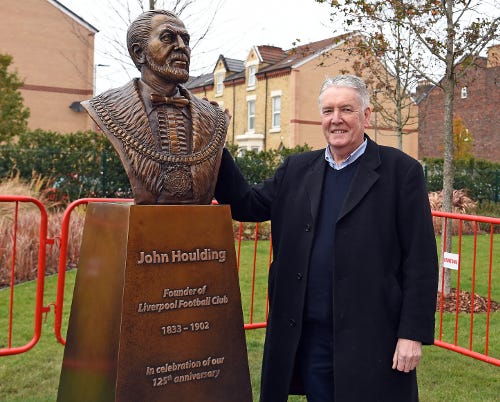It’s strange, in a way, to think how something so monumental could rise from something as bitter as a dispute over rent. But that’s the reality. Liverpool Football Club was not born out of triumph, nor the kind of romantic beginnings you might expect from one of the world’s greatest football institutions. It was forged in frustration, disagreement and, most crucially, defiance. And the date that changed everything? June the 19th, 1892.
Back then, Liverpool was already a thriving city, busy with dockyard labour and shrouded in coal smoke. It was an industrial powerhouse, but its heart beat increasingly in rhythm with the game of football. And at that time, Everton were the city’s footballing pride, one of the founding members of the Football League, and playing their matches at a ground called Anfield.
It’s remarkable now to think of it, but Anfield was once Everton’s home. That much is often overlooked in modern discussions. Yet, this was where it all began. It was not some grand vision or glorious purpose that set Liverpool FC in motion, but rather a power struggle over control, influence and money.
The Boardroom Dispute That Changed Everything
At the centre of the storm was John Houlding. A successful businessman, a conservative councillor, and crucially, the owner of Anfield. He was also the sitting president of Everton Football Club. Under his leadership, Everton had thrived, building a strong reputation and attracting large crowds. But tensions grew. Houlding was accused of using his position to enrich himself, raising the rent on Anfield and interfering too much in club matters.
By early 1892, it had all reached a head. The Everton board, disillusioned and unwilling to yield to Houlding’s demands, made a drastic decision. They left Anfield behind and moved across Stanley Park to build what we now know as Goodison Park.
Houlding found himself with a stadium but no team. Many in his position would have taken the hit and walked away. But Houlding was not like most men. He refused to accept the loss, and instead, he acted.
On June the 19th, 1892, he registered a new club, initially under the name Everton Athletic. The Football Association rejected the proposal, fearing it would cause confusion with the existing Everton club. So, Houlding doubled down and embraced the identity of the city itself.
Liverpool Football Club was born.
A Swift Rise Built on Scottish Steel
With a name in place and a point to prove, Houlding turned to John McKenna, another prominent figure in the football world and a fellow Scot. McKenna was tasked with assembling a squad, and he knew exactly where to go. He headed north to Scotland, recruiting a group of talented players whose surnames soon gave the team its first nickname – the “Team of Macs”.
Liverpool’s first match came on September the 1st, 1892, in the form of a friendly against Rotherham Town. It was a modest affair in terms of crowd, but the result was emphatic – a 7-1 win that sent confidence surging through the new side.
That momentum carried into their first competitive season in the Lancashire League, which they won at the first attempt. By the following year, they were elected to the second division of the Football League. Come 1894, Liverpool had already achieved promotion to the top flight.
In the space of just two years, the club had risen from a makeshift solution to a recognised force in English football. And yet, that was only the beginning.
Shankly, Paisley, Klopp – Giants Who Built the Empire
The decades that followed were full of transformation, tradition and, of course, trophies. But at every stage of that journey, Liverpool stayed close to its roots – built not just on talent but on character, not just on results but on resilience.
Bill Shankly changed everything. He understood the people of Liverpool. He built the club from the boot room up, not just managing a side but shaping a philosophy. Under him, Liverpool became a team that matched the identity of the city – working-class, passionate and unrelenting.
Bob Paisley followed, taking Shankly’s foundation and turning it into a dynasty. His Liverpool side dominated Europe, collecting trophies with a calm ruthlessness that stunned the continent. The 70s and 80s were marked by glory, and Liverpool were feared and respected in equal measure.
Fast forward to recent years, and Jürgen Klopp brought the belief back. Under his leadership, Liverpool once again stood among the elite. The Champions League returned to Anfield. The Premier League title, so long out of reach, was finally secured. Klopp’s Liverpool reminded us that this club does not just survive, it thrives.
Liverpool’s Soul Runs Deeper Than Silverware
But for all the silverware, what truly defines Liverpool Football Club is not what sits in the trophy cabinet. It’s the people, the passion, and the perseverance. From the thunderous roar of the Kop to the spine-tingling strains of “You’ll Never Walk Alone” that echo in Istanbul, in Madrid, and in every corner of the planet – Liverpool is about belief.
And that belief was born on a quiet Sunday in June 1892.
Liverpool FC began not with a ticker tape parade, but with a refusal to accept defeat. It emerged from a boardroom split and a desire to prove something different was possible. That story still speaks to fans today. It explains the fire in the bellies of those who sing louder, travel further and believe harder than anyone else.
Every matchday at Anfield, every banner raised in the stands, every tear shed in victory or defeat – it all traces back to that defiant first step.
So when we speak of legacy, when we talk of the weight of the badge or the meaning behind the name, we’re not just talking about football. We’re talking about the soul of a city and a symbol of what can be built when belief stands taller than adversity.
And that all began, on this very day, in 1892.








